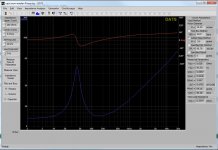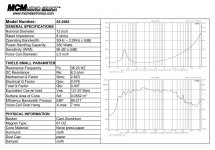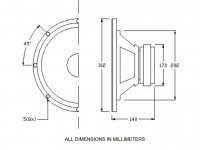Hello there,
I am looking to use this woofer,
https://www.newark.com/mcm-audio-select/55-2982/woofer-12-die-cast-350w-rms/dp/13T7694
http://www.farnell.com/datasheets/2329552.pdf
In a dual woofer Ripole subwoofer.
I just broke the woofer in for 4 hours at 20 Hz and have included the DATs screenshot.
Here are I think all the relevant parameters as measured by me,
F(s) = 41.72 Hz
Q(ts) = 0.6957
V(as) = 90.28 liters
SPL = 90.79 dB SPL 1W/1m
R(e) = 6.638 Ohms
Q(es) = 0.8446
Piston diameter = 260.4mm
SPL = 91.6 dB SPL 2.83 Vrms
C(ms) = 0.227 mm/N
L(e) = 0.6765 mH at 10kHz
Q(ms) = 3.947
BL = 11.5
n(0) = 0.7402%
M(ms) = 64.16 grams
Xmax = 7 mm
SD = 552 cm^2
I know the generally accepted rule of thumb is supposed to be,
"Area of front chamber opening should be 1/3 to 1/4 of woofers’ piston area (SD). For woofers having more than 10mm X-max, use 1/3 SD minimum.For woofers with 10mm or less X-max, chamber area can be 1/4 SD.
Area of rear chamber opening should be 1/2 to 1 SD."
But there has to be more to it than that.
I would love to be able to simulate this is AJHorn, but I cannot find enough example pictures online in order to figure out the German software.
Hornresp is not user friendly enough for me to learn just for this one use.
I know Axel Ridtahler has a custom AkAbak script that he uses.
Is there anyway to properly sim a Riplole Dipole Subwoofer?
I am looking to use this woofer,
https://www.newark.com/mcm-audio-select/55-2982/woofer-12-die-cast-350w-rms/dp/13T7694
http://www.farnell.com/datasheets/2329552.pdf
In a dual woofer Ripole subwoofer.
I just broke the woofer in for 4 hours at 20 Hz and have included the DATs screenshot.
Here are I think all the relevant parameters as measured by me,
F(s) = 41.72 Hz
Q(ts) = 0.6957
V(as) = 90.28 liters
SPL = 90.79 dB SPL 1W/1m
R(e) = 6.638 Ohms
Q(es) = 0.8446
Piston diameter = 260.4mm
SPL = 91.6 dB SPL 2.83 Vrms
C(ms) = 0.227 mm/N
L(e) = 0.6765 mH at 10kHz
Q(ms) = 3.947
BL = 11.5
n(0) = 0.7402%
M(ms) = 64.16 grams
Xmax = 7 mm
SD = 552 cm^2
I know the generally accepted rule of thumb is supposed to be,
"Area of front chamber opening should be 1/3 to 1/4 of woofers’ piston area (SD). For woofers having more than 10mm X-max, use 1/3 SD minimum.For woofers with 10mm or less X-max, chamber area can be 1/4 SD.
Area of rear chamber opening should be 1/2 to 1 SD."
But there has to be more to it than that.
I would love to be able to simulate this is AJHorn, but I cannot find enough example pictures online in order to figure out the German software.
Hornresp is not user friendly enough for me to learn just for this one use.
I know Axel Ridtahler has a custom AkAbak script that he uses.
Is there anyway to properly sim a Riplole Dipole Subwoofer?
Attachments
Sadly, the majority of woofers MCM sells do not make spec.
Hence why I posted the spec's I measured...
The best way I know to "model" the output of dipole subs is to build the sub, measure the nearfield frequency response in the plane of the front and rear openings, and then use those as part of a model of the far field response. I do this all the time, but you would need my ACD spreadsheets to do it. For frequencies below a couple hundred Hertz, this is a very accurate way to determine the far field response for a dipole sub.
- Status
- This old topic is closed. If you want to reopen this topic, contact a moderator using the "Report Post" button.


